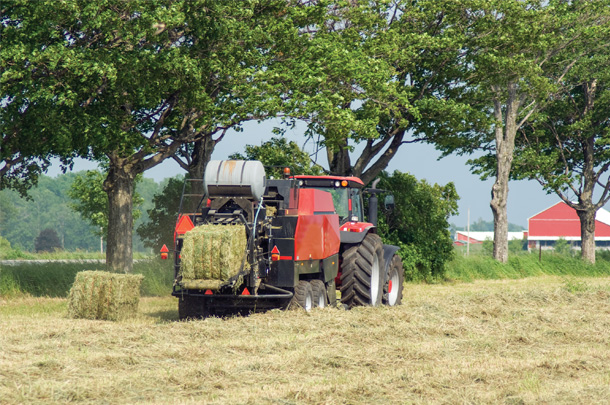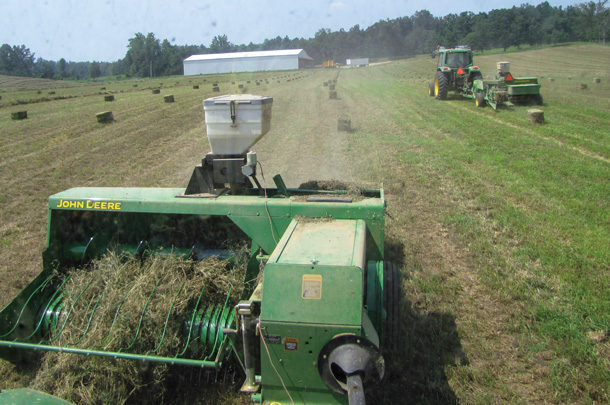Weather during harvest can be the biggest challenge in putting up high-quality hay. If hay is still a bit wet but a storm is coming and you want to get it baled and stored before the rain, you might consider using inoculants and hay preservatives. If used correctly, these additives can be beneficial.
Ideal storage moisture depends on bale size. According to agronomy extension specialists at South Dakota State University, small square bales should be baled/stored at about 18%-20% moisture and larger bales about 3%-5% dryer to prevent heating and mold. When moisture levels exceed these ranges, a hay preservative or inoculant may be appropriate, but if moisture reaches more than 30%, these won’t help.
Inoculants and preservatives
There are several products designed to help keep hay from heating and spoiling. Bacterial inoculants add more “good” bacteria to aid fermentation and improve aerobic stability (stopping mold growth). These bacteria occur naturally in many plants; inoculants simply add more.
They work best on hay that is wetter than good baling conditions, but less than 25% moisture. Inoculants should be applied uniformly as hay is baled and before any rain gets on it. They help protect against small moisture changes (3%-5% higher than you would typically bale) to reduce or stop mold growth, improve hay quality and palatability, and maintain green color.
Hay preservatives are different than inoculants and different than desiccants, which are drying agents applied at cutting to increase drying rate. Preservatives are applied to hay as it is baled to minimize spoilage during storage. Both products are usually applied through a spray system, either on the mower (for desiccants) or on the baler (for preservatives).
A preservative can be applied through spray nozzles fastened above the pickup attachment on the baler, which is common for large round balers, or discharged directly onto the hay within the bale chamber for small or large square bales. Preservatives prevent heating of hay baled at higher moistures by inhibiting growth of aerobic microbes. They allow hay to be baled sooner, reducing the time it lies in the field exposed to precipitation risk.
Preservatives are cost-effective if used as needed to prevent rain damage, when applied uniformly to the windrow as it enters the baler. The most effective preservatives for alfalfa are organic acids, mainly propionate (propionic acid) and acetate (acetic acid).
Effective application relies on using proper rate (dependent on moisture content and size of bale) and quality of forage. Preservatives containing high amounts of propionic acid are generally effective in reducing spontaneous heating in moist hay, but ammonium propionate (buffered propionic acid) is often recommended because it’s less caustic. The preservative should be sprayed using the most uniform application possible.
Small bales ranging from 20%-25% moisture should be treated with approximately 0.5% propionic acid. A 1% increase in application rate may be needed for hay with 25%-30% moisture. Many studies have shown no benefit from preservatives used on hay that’s over 30% moisture.
Research has shown that propionic acid, as well as buffered propionic acid, is not harmful to animals. Since propionic acid is corrosive, however, and can cause damage to machines, buffered acids and salts of acids have been developed to help overcome some of these issues. Both propionic acid and buffered forms can cause hay discoloration but may help protect feed value.
Are preservative applicators cost-effective?
Even though hay might be higher-quality/higher-value when preservatives are used judiciously, some producers are hesitant to invest in preservative applicators, thinking these are too expensive or too complicated. “They are more affordable and simpler than you may think,” says Andrew Frankenfield, agronomy extension educator, Penn State Extension. “With challenges of making dry hay, this may be a change you can’t afford not to make.”
Many times, hay is almost ready to bale but a little tough and you go ahead and bale it and hope it doesn’t mold. “These are the times you wish you had a preservative applicator, so you could bale and not have problems.” Yet you hesitate to buy one, thinking applicators are too expensive if you are only baling a couple thousand small square bales a year.
“You can buy a 25-gallon baler liquid applicator for around 500 dollars. These are not complicated – just a small electric sprayer you mount on the baler,” he says. You also need a baler-mounted moisture tester so you can assess moisture of the hay as you bale it.
“A moisture tester can be purchased for 350 to 500 dollars. For less than 1,000 dollars you can outfit your baler with ability to apply a hay preservative when conditions are not perfect and get the hay off the field before rain destroys quality.”

Getty Images.
If you want something fancier, you can spend several thousand dollars for fully automatic controls. These systems have a monitor that regulates flow of the preservative depending on moisture content of the hay, and with use of an electric eye, the applicator turns off and on when hay is flowing through the baler pickup. You can get the same results, however, with cheaper models.
“Consider the value of 5 acres of hay that you don’t get baled because of rain. It could have been worth 2,500 dollars [$250 a ton times 2 tons per acre times 5 acres], but now is only worth about half as much – maybe 125 dollars a ton and valued at 1,250 dollars. The 1,250 dollar lost could have paid for the applicator, moisture tester and preservative, and you’d still have money left in your pocket,” says Frankenfield.
How much will it cost to apply preservative to small square bales? “You can buy various types of preservatives in multiple unit sizes. One product for example: If you buy a 50-gallon drum [450 pounds], [it] costs about 450 dollars or one dollar per pound. If you buy a 275-gallon tote [2,380 pounds], it costs about 2,000 dollars or 84 cents per pound,” he says.
He gives examples, looking at stem moisture, application rates for small square or round bales and application costs per ton (based on $1 per pound). When stem moisture is 22% and under, preservative should be applied at 4 pounds per ton, at a cost of $4 per ton. Stem moisture of 23% to 25% would require 8 pounds per ton, or $8 a ton. Stem moisture of 27% to 30% would require 16 pounds per ton, at $16 per ton. Anything above 30% moisture should not be baled.
For larger square bales: stem moisture of 22% and under requires 6 pounds per ton, or $6; stem moisture of 23% to 26% requires 10 pounds per ton. If moisture is 27% or above, do not bale.
When calculating how much preservative to apply, he says it’s like calibrating a sprayer, but instead of gallons per acre, you calculate pounds per ton. “Figure out how many tons per hour you bale. Count the number of small square bales you make in three minutes. Let’s say it’s 15 bales. Weigh several bales to get average weight. If they are 40 pounds and you bale 15 bales in 3 minutes, in an hour of baling you’d bale 300 bales with average weight of 40 pounds. 40 [pounds] times 300 [bales] equals 12,000 pounds per hour or 6 tons per hour.”
In this scenario, to apply 4 pounds of preservative per ton, you’d need 24 pounds per hour. “If the preservative weighs 9 pounds per gallon, that’s 2.7 gallons per hour or 0.045 gallons per minute. The preservative is slightly heavier than water,” he says.
“In this example we would use one TP110050 spray tip at 35-40 psi to achieve our desired 4 pounds of preservative per ton of hay. If we need 8 pounds per ton, we can turn on a second spray tip or replace the single TP110050 tip with a tip with twice the output, such as TP11001,” says Frankenfield.
The applicator for your baler may pay for itself the first year you install it.











